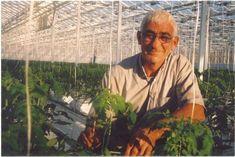
After three years of applied scientific research Flandria tomato producers in Belgium have made the requisite investment to be able to supply a reasonable quantity of winter tomatoes from 2004 on, covering the period between mid-January and the end of March. For retailers this means an end to the notorious ëgap' in winter supply.
Producer Louis Scheers is one of the pioneers in this area. Together with his son Kurt he runs a tomato farm in Kontich, south of Antwerp. They have learned both the positive and the negative lessons from the applied scientific research conducted in Meerle (Noorderkempen experimental nursery) and have taken the plunge. In mid-October they planted 8,000 square metres of Palmiro tomato plants under glass. They expect to be able to deliver the first crop to the auction on January 20.
With a view to the production of winter tomatoes, Scheers has invested some €743,000 in glasshouse infrastructure. A large proportion of this went on computer-controlled lighting.
He describes the risk he is taking as “calculated”, adding: “Retailers and consumers want a reliable supply of safe, high-quality tomatoes in the winter as well. In other words, tomatoes that have a full flavour, look beautiful and offer guarantees in terms of environmentally friendly cultivation techniques and food safety. That's why I decided to comply fully with the standards of the Flandria specifications for my winter tomatoes.”
The constant demand of the customers convinced him to make the move. And the ability to supply branded tomatoes year-round strengthens the Flandria marketing mix
Research showed Scheers, for example, that August is too early for planting, which is why it has now been postponed until mid-October. The researchers also found that bumblebees and natural enemies were less active in the winter months. To offset this, the number of bumble bees, ichneumon flies, and other insects introduced has been increased.
The research also yielded some crucial tips about lighting. Scheers said: “The intention is not to make Flandria winter tomatoes an artificial product. We'll just be giving nature a helping hand. We start using artificial lighting from the middle of November: two hours before sunrise and two hours after sunset. The lights don't all come on or go out at the same time, however. As in nature it slowly gets light and slowly gets dark in the glasshouse. The computer ensures that the lighting is switched on two hours before sunrise, at first dimly and then gradually getting stronger until natural daylight takes over. During the two hours after sunset the lighting progressively gets dimmer. The lights that come on first in the morning are also switched off first. That way we make sure it's a natural process, albeit for a few hours longer than normal daylight. The tomato plants are in complete darkness for at least ten hours. This ensures that their biological day-night rhythm is respected.”
Taste research and blind tastings carried out by the Provincial Centre for Applied Research on Vegetables in Kruishoutem during the 2000-2002 test period had already demonstrated that the quality of Flandria winter tomatoes was surprisingly good.
Shelf-life, firmness and sugar content were comparable with the same varieties grown traditionally (without artificial lighting) in the summer months. Trained taste panellists also came to the conclusion, based on comparative blind tasting, that their flavour was better than that of the winter tomatoes grown in southern European production areas.



